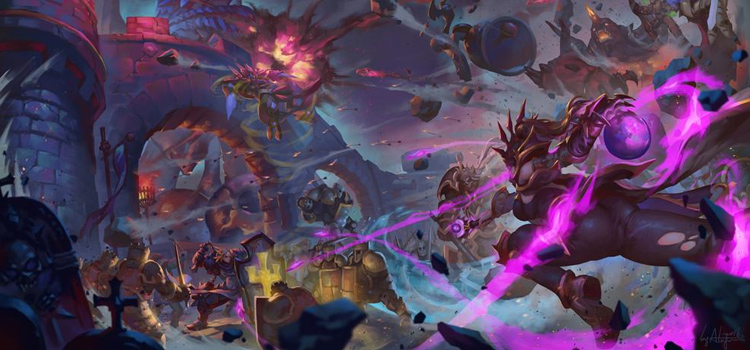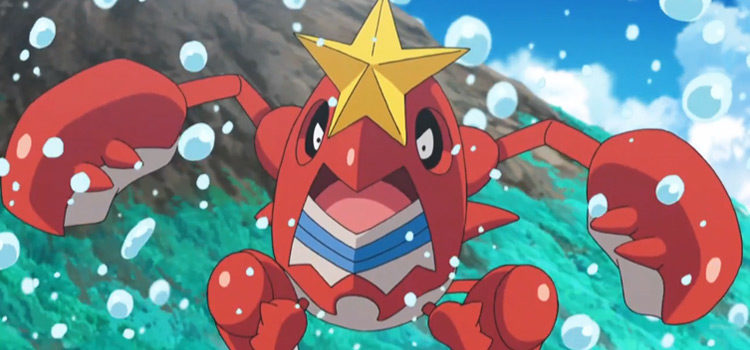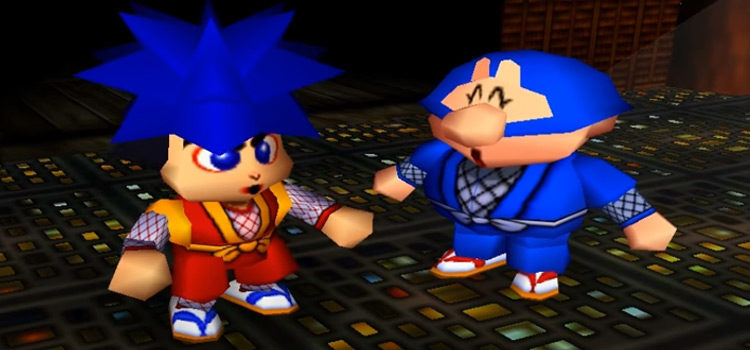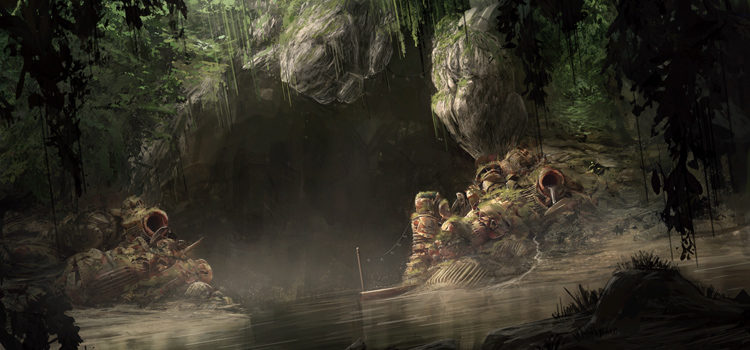Most Underrated Spells in D&D 5e (Ranked)
This post may contain affiliate links. If you buy something we may get a small commission at no extra cost to you. (Learn more).
It seems like there are a handful of spells that get picked more often than others.
It’s tough to choose lesser-used spells because, most of the time, it means forgoing the big spells like Counterspell, Fireball, Mirror Image or Misty Step.
It’s difficult to ignore the common spells because they’re just so good or very iconic. But there are some real gems that do get passed over, and these are some D&D spells that deserve a bit more love.
The spells in this list might not be the absolute best.
But if used properly, or given the right circumstances, these could easily match or outperform some of the usual spells we’re familiar with.
10. Aid
Type: 2nd-level Abjuration
Aid grants an additional 5 hit points for three creatures over the duration of 8 hours. It’s not a bad pick up for Bards if they want to further their options to support.
Aid may not sound too special at first glance. But having an extra 5 hit points without the need for concentration over the course of an entire adventuring day is pretty strong. The effect stays active after a short rest as well.
On top of that, these hit points aren’t temporary hit points, but an 8 hour increase to max health.
When Aid is up-cast with a 5th level spell slot, three creatures now get an extra 20 hit points. If a creature under effect of Aid is damaged, they can be healed back up above their regular hit points. It’d be as if a creature with Aid was given extra Constitution for the purposes of max health.
One misconception that most players have is that Aid won’t translate well into higher-leveled play when creatures consistently do 20 – 30 damage per hit. These extra hit points can be very impactful.
The max health increase from Aid stacks with temporary hit points as well. This means that an average Charisma character at 11th level with Hero’s Feast, Inspiring Leader, and Aid can easily snag 30 extra hit points.
Not needing concentration and having a long duration means using Aid can be used proactively for a party’s survivability, too. Most other spells that grant temporary hit points or increase Armor Class don’t last very long.
Aid is definitely a spell you don’t want to underestimate.
9. Enlarge/Reduce
Type: 2nd-level Transmutation
Enlarge/Reduce is one of those Swiss-army-knife spells, since you get the benefit of two spells for only investing in one.
It can be used on an ally, an enemy, or as a utility spell to change the size of an object.
Enlarge/Reduce needs concentration to maintain, and only lasts for a minute. But you can change the size of an object or item that isn’t being worn, wielded, or carried, and if it’s cast on an unwilling creature, it requires a Constitution saving throw.
If a creature is Enlarged or Reduced, everything they’re wearing or carrying is enlarged (or reduced) with them.
When Enlarged, a creature’s size is doubled, moving it up by one size category. So a medium to large, a large to huge, and so on. This also means a creature’s weight is increases by a factor of 8.
Reducing a creature works the other way around. A Reduced creature’s weight is reduced by 1/8th of normal, and its dimensions are halved, taking it down one size category.
This spell also affects weapon attacks made by the affected creature. An enlarged creature adds an extra d4 to their weapon attacks, while a reduced creature subtracts a d4 from their damage.
Large creatures get an advantage on Ability Checks and Saving Throws involving Strength, but not when it comes to attacks. A reduced creature, on the same checks, gets a disadvantage but not on attacks.
Looking at this spell as a way to increase or decrease someone’s damage output is selling the Enlarge/Reduce spell short. Utility is where this spell shines.
Suddenly, puzzles with heavy objects become easier. If everyone needs to jump over a ravine, the Wizard or Sorcerer could simply Reduce in size, climb onto someone’s back, and bypass the need for an Athletics check.
Even if the Wizard or Sorcerer weighed 165lbs, they now weigh 1/8th of that… or about 20lbs, which is an easy lift for most characters.
Maybe you found a chest of treasure weighing 800lbs and want to carry it outside? Reduce it and it’s now an easy 100lb chest to lift.
Though you might have to keep recasting Reduce, it’ll save you a lot of trouble.
8. Sleet Storm
Type: 3rd-level Conjuration
Sleet Storm has a huge area of effect, with an 80ft diameter in a 20ft cylinder.
Sleet Storm fills the affected area with ice, sleet, and snow, turning the ground into difficult terrain and the entire area is now heavily obscured.
Whenever a creature enters or is in the area of effect, they must pass a Dexterity saving throw or fall prone.
Once prone, a creature has to use their movement action and half their movement to get back up. Their movement is then halved even more since they’re traversing difficult terrain. Most creatures have a speed of 30ft, so they’ll only really be able to move about 5ft when in the Sleet Storm.
If they’re caught in the middle of Sleet Storm’s effect or have to pass it to get to somewhere, Sleet Storm will buy your party a lot of time to reposition, strategize, or hide.
This makes Sleet Storm an amazing battlefield control spell, but this spell is often overlooked because it doesn’t do damage. But it can still be used in combination with a few attacks.
Spellcasters could combine Sleet Storm with other deadly area of effect spells like Fireball.
Spellcasters in the Sleet Storm are forced to make a Constitution saving throw for concentration. And spellcasters who rely on the War Caster feat to make their concentration checks can’t apply it to Sleet Storm, since there’s no damage being done.
7. Otiluke’s Resilient Sphere
Type: 4th-level Evocation
Otiluke’s Resilient Sphere is an excellent way to shut down low Dexterity characters for a round.
This not only includes the clumsy enemy Barbarian, but enemy Spellcasters as well.
Use Otiluke’s Resilient Sphere to keep them still while other party members close the gap.
While it is a high level spell, it’s worth using. Especially when you’re in a hallway surrounded by traps and don’t have access to a Rogue, since the sphere makes any creature inside invincible to any damage coming from the outside.
It’s also pretty neat that you could just traverse a pool of lava or survive a dragon’s breath, and not worry about dying a horrible death.
Since Otiluke’s Resilient Sphere is weightless, it could also be used to lift large creatures and throw them off a cliff.
6. Shocking Grasp
Type: Evocation Cantrip
Most players avoid Shocking Grasp because it’s a touch spell.
As a spellcaster, you normally want to avoid getting into melee combat range as much as possible. This, however, can’t always be the case. Sometimes you’ll be forced into melee range.
When a frail Wizard is looking down an angry Barbarian, there may not be a way to escape. This is where Shocking Grasp comes in.
If the enemy Barbarian is hit with Shocking Grasp, they can’t take a reaction. Which means the Wizard can run away without provoking an attack of opportunity, and you do some lightning damage.
Not bad for a Cantrip.
5. Color Spray
Type: 1st-level Illusion
Color Spray shares the same mechanic as Sleep.
You roll for the amount of Hit Points the spell can effect, but instead of putting enemies to sleep, Color Spray blinds enemies until the caster’s next turn.
For an entire round, multiple creatures are blinded by a 1st level spell with no saving throws. The only way out is to just have more hit points.
Color Spray may not deal any damage, but being blind for an entire round is debilitating at any level. And being able to up-cast it with higher level spell slots makes it even better.
4. Rope Trick
Type: 2nd-level Transmutation
By touching the end of a rope of up to 60ft, an extra dimensional space is created where up to eight creatures can take shelter.
To get to the extra dimensional space, the rope must be climbed. But once inside, the rope can be pulled in so no other creatures can enter.
Attacks and Spells can’t enter the space, either.
This should allow spellcasters to synergize Rope Trick with concentration spells, since Rope Trick doesn’t require concentration. Just cast Haste or Fly on an ally in combat and guarantee your concentration won’t be broken, since you’ll be safely hidden in the extra dimensional pocket. And of course you can still see the fight from inside.
A 2nd-level spell with this much utility can be very strong, even at higher level play.
3. Cloudkill
Type: 5th-level Conjuration
Cloudkill is known to be a pretty good spell. But most players don’t actually grasp how powerful of a spell it is.
While it’s known that it’s a damage area of effect spell, most forget that Cloudkill heavily obscures an area, rendering creatures in its area of effect blind.
So if you drop Cloudkill on a group of enemies, not only will they be hurting from the poison damage, but they wouldn’t know where to run, which direction their enemies are in, or who to attack.
Cloudkill disrupts the enemy fast, forces them to blindly reposition, and deal tons of damage. What’s not to love?
Corner your enemies or put one in a choke point, and the encounter is pretty much over.
2. Wind Walk
Type: 6th-level Transmutation
Wind Walk is a Druid exclusive 6th-level spell and takes a minute to cast.
Wind Walk turns 10 willing creatures into a gas cloud with a crazy 300ft movement speed that’s resistant to all non-magical weapon damage.
When in the gaseous form, the only action the creatures can perform is the Dash action, doubling the 300ft to 600ft a round. A gaseous form that moves at 600ft a minute is essentially gaining access to an invisible flying car.
This allows a party to cover large distances fairly quickly.
It takes a minute to convert yourself into (and out of) the gaseous form, so it can’t be used for quick escapes while in combat. But it can be used as an infiltration spell to get into an area.
Most creatures wouldn’t even second guess why a dust cloud just passed by.
1. Prismatic Wall
Type: 9th-level Abjuration
As a 9th-level spell, Prismatic Wall has to be good if it’s worth taking over Wish, Meteor Swarm, or Mass Heal, especially since you’ll only get one of these per rest.
In my opinion, Prismatic Wall is definitely one of those underrated spells.
Anyone within 20ft of the Prismatic Wall must make a Constitution saving throw or be blinded for an entire minute. In addition, no saving throws can be made until that minute is over.
If anyone wants to pass through the wall, they have to go through all seven colored layers of the Prismatic Wall. Breaking through each layer requires a Dexterity saving throw, and each layer has a unique effect if the saving throw fails.
The deeper anyone gets into the Prismatic Wall, the more devastating the effects of failure.
The second to last layer petrifies, while the last layer can blind again and teleport them to another plane of existence.
There’s a lot of fun to be had with this one.






